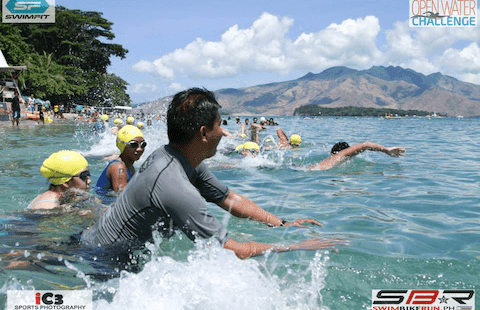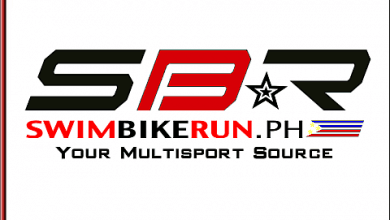Appropriate Race Day Swim Gear That Can Make You Swim Faster

As the triathlon world has its eyes on the Ironman World Championships this weekend, in the warm waters of Hawaii, you will likely see most of the participants using a speedsuit for the swim leg of the Ironman.
The speedsuit is an option for non-wetsuit swims, and while it may look like an ordinary triathlon suit, it is very different and much faster.
SBR.ph admin Carlos de Guzman at the TIMEX 226 Bohol Triathlon rocking the SLS3 Fobic Speedsuit
The article below was written based on years of watching age group triathletes in South East Asian races, in which the wetsuit isn’t legal as the water is just too hot. You will learn the options that you have when it comes to race day gear for the swim portion.
You will also learn about the different in training needed in case of a wetsuit swim as it’s the case with many Ironman races done by Asian athletes since wetsuit swims is the normal rule in most triathlon races around the world other than South East Asia and some races in the Southern Hemisphere.
Most beginners may not be able to spot the different of a speedsuit to a standard trisuit as they look similar but perform very different in the water. Some beginners may not be able to spot the different of a speedsuit to a standard trisuit as they look similar but perform very different in the water.
Benefits of a speedsuit
A speedsuit is a thik, tight and hydrodynamic layer that you use on the top of your trisuit or tritop/trishorts. It’s likely one of the best investments you can make towards a faster overall finish time, and it will also give you some more comfort and benefits on the bike and run, understand below why.
Hydrodynamic – Faster in the water
The fabric used on the speedsuit is water repellent, which means that it’s even faster than the human skin, and much, much faster than the lycra that is used by most of the triathlon suits these days. When it comes to numbers, the below is the average result of a test I ran with my training squad, please note that it does vary from athlete to athlete depending on their technique and also brands and models.
Speedsuit VS human skin (on a tight/race swimsuit) = 1sec/100m (15 seconds faster over 1500m swim)
Speedsuit VS a decent/shortcourse trisuit (no pockets) = 3sec/100m (60 seconds faster over 1500m swim)
Speedsuit VS a slow / long course trisuit or two pieces, both with exposed pockets = 5sec/100m (90 seconds faster over 1500m swim)
Now go and think how much you work you need to put in to improve 1min of our time in a 1.500mts swim race. This makes the speedsuit a great investment as you lost virtually no time to take it off in transition (should be no more than 5 seconds)
Benefits on the bike and run
The benefits don’t stop there. The speedsuit also allows you to race with your favourite trisuit or two-piece, especially on long course events that you may want to have pockets to stock up on gels and other things. It makes this combo the best of both worlds, fastest in the water and most comfortable out of the water
Strategy Benefits
For the very high performance athletes, it may be the difference of swimming “one pack ahead” which can be a decisive factor on who you will be riding with. Another way to see it is that you will be 1-2min ahead of your usual pack on the bike, so you can take that time to take it a bit easier early on the bike and wait until they come, you will be fresh and ready to go while they will have started the bike too fast. This will make a big difference for the rest of the day. Pacing off strong athletes on the bike isn’t anything new and every second on the swim counts.
Using a speedsuit, allows you to run with a two-piece underneath with no time penalty in the swim
Using a speedsuit, allows you to cycle and run with a two-piece underneath that may be superior in comfort and with no time penalty in the swim
How to train for a wetsuit race
Now that you understood the benefits of a speedsuit for non-wetsuit swims, which is the reality of most races in South East Asia, you need also to learn about the wetsuit, the rubberized equipment that is allowed and even compulsory in most other races, including East Asia and Australia, two popular racing destinations for Asia based triathletes
If you ever swam on a wetsuit before, you know that it can make your shoulders fatigue a lot earlier than the usual. This happens as a combination of a different body position & restricting shoulder movement, event the most advanced and flexible wetsuits aren’t as loose as a non-wetsuit swim stroke. The good news is that you can do something about it to improve that feel and make sure the swim won’t drain you more than it should:
Train with it:
Try to use your wetsuit once a week in the last 6 weeks leading into the race. If the pool water is too warm you can take 2 bottles of iced water and make yourself cooler by drinking it and pouring on your head on the intervals. If water temperature is over 26 degrees, then use the wetsuit only for the warm up or first half of the session, then add the pull gear as explained below. Alternative, do an extra swim session of 20-30min with the suit.
Tools that simulates it
Use pullbuoy/paddles/bands for your long swims even if your programme doesn’t say so. The pullbuoy will lift your body like the suits does, while the paddles will also add some strength load on your shoulders simulating the extra load of the suit. Ankle bands should only be used by experienced swimmers (faster than 1’50/100 on 1.5k), as you won’t need to kick much with the suit and you want to get used to swimming that way
Tips for race day
The neoprene absorbs and holds the water for ~24h and that makes it more flexible. Just like before your swim training with the suit, on race day you should also take your suit to the shower as it will be moist and way more flexible than if you just put it on and swim on race day.
Pull the arms all the way to the armpit for more comfort
Pull the legs all the way up to your groin
Let some water in before you swim, it will let the suit “settle” and also moist. Do it by pulling the suit collar in the water
Let some water in before you finish the swim. Just before you exit the water, pull the collar and let it it.. It will make transitions much faster
You may consider cutting your suit if its too long in the legs, the buoyancy gains there are minimal and they can get stuck on your feet in transition. The appropriate height is in the middle of your calf.
Enjoy your training.
By : Coach Vinnie Santana | ironguides.net
For : SWIMBIKERUN.ph
ironguides is the leading Lifestyle Facilitation company for athletes of all abilities. We provide coaching and training services, plans and programs, as well training education, health and fitness products to help you learn and live a healthy lifestyle. Come get fit with one of our monthly training subscriptions, event-specific training plans, coaching services,a triathlon training camp in an exotic location! ironguides also provides Corporate Health services including Corporate Triathlons, Healthy Living retreats and speaking engagements. At ironguides, your best is our business!











